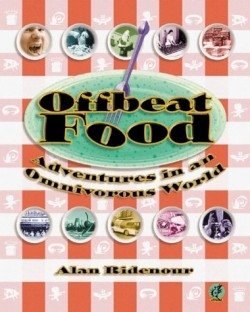Offbeat Food
Adventures in an Omnivorous World
Long before SPAM became a synonym for questionable e-mail, it was a synonym for questionable foodstuffs. Maybe that’s the link, since the name describes something that’s filling and of unknown quality. Offbeat Food contains hundreds of interesting, amusing (and, at times, unsettling) factoids about all things edible, as well as some things that are not.
Advertising agencies can go through agonizing processes to get their food products to look their best. Somehow the TV dinner never quite looks as appetizing out of the box as it does on it. Ridenour reveals some of the secrets of the trade. For example, substituting shaving cream for whipped cream and mashed potatoes for ice cream have long been “accepted” practice since the real McCoys can’t stand up to the intense heat of the Klieg lights. Soup looks fuller on TV because of the addition of that special ingredient that grandma never added: marbles.
Is apple pie truly American? Doubtful, but the cream pies made famous in Mack Sennett’s silent-film comedies undoubtedly are. Ridenour devotes a section to “Yummy Cinema,” films which incorporate food as their main theme (Soylent Green, Babette’s Feast, Big Night).
He also reveals the folklore behind such all-time favorites as Twinkies, Fluff, Velveeta, Pez, and Jell-o, to name just a few. Love them or hate them, they have become part of America’s epicurean culture.
Some habits involving eating are less palatable. The author makes no bones about the instances of cannibalism, both as religious ritual and just plain criminal behavior. While readers may be put off by the thought of chewing on a Chihuahua or munching on a Manx, some cultures thrive on such eclectic fare, just as they look down their collective noses at some American customs. Singapore, for example, prohibits the import, ownership, and use of chewing gum, practically a national staple here.
Other chapters include the religious significance of food and festivals, the invention and evolution of fast food, food and art, and, of course, food and sex.
Reviewed by
Ron Kaplan
Disclosure: This article is not an endorsement, but a review. The publisher of this book provided free copies of the book to have their book reviewed by a professional reviewer. No fee was paid by the publisher for this review. Foreword Reviews only recommends books that we love. Foreword Magazine, Inc. is disclosing this in accordance with the Federal Trade Commission’s 16 CFR, Part 255.

